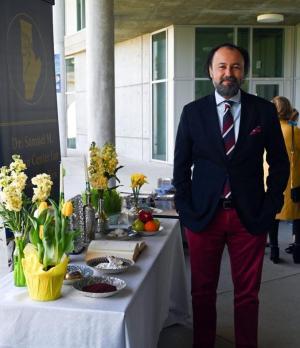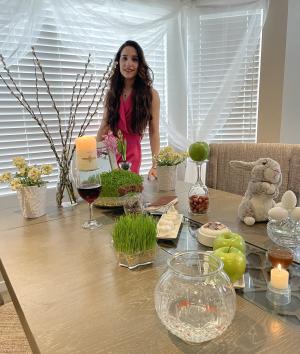
By Nikki Babri
As spring blossoms, communities across the globe eagerly await the arrival of Nowruz ("new day"), heralding the Persian New Year. Celebrated by over 300 million people globally, Nowruz transcends cultural, religious and geographic boundaries as its celebrants usher in the new year with feelings of hope and renewal.
Professor of History and Maseeh Chair in Persian Studies Touraj Daryaee emphasizes UCI’s pivotal role in fostering a vibrant community of Iranian scholars and enthusiasts. "Iranians, regardless of their religious and political affiliation, come together to celebrate the coming of spring, life and the New Year,” he says.

Daryaee also serves as director of the Samuel M. Jordan Center for Persian Studies and Culture, a dynamic interdisciplinary hub within the School of Humanities that focuses on Iran and the Persianate world. Founded in 2009, it stands as the first UC center exclusively devoted to Persian studies and hosts conferences and research clusters for scholars. The center also organizes annual cultural events, including Nowruz celebrations, to involve the local community in Persian culture and scholarship.
“Nowruz symbolizes the beginning of spring, the rebirth of nature and a fresh start for individuals and Iranian communities. It is an opportunity to gather with family and friends, reflect on the past year and look forward with optimism to the year ahead,” shares Simin Amini, a Ph.D. student in visual studies with a specialization in the archaeology of Ancient Iran.
Nowruz traditions across the diaspora
Despite distance and cultural assimilation, many Nowruz traditions persist within the Iranian diaspora. These customs offer community for Iranians separated from their homeland, serving as reminders of resilience, unity and cultural identity, cultivating a sense of kinship across generations.
Erisa Taghizadeh, a fourth-year transfer student majoring in biological sciences and minoring in Persian studies, reflects on her family's Nowruz customs. “In our house, we do khooneh tekooni ("shaking the house" or spring cleaning) or else Nowruz won’t come,” she explains. “With all its good and bad, one year has passed. Now it is time to look forward to new beginnings while remembering the lessons from the past.”
In Iran, spring cleaning symbolizes renewal, as individuals wash away the old year's dust and misfortune, creating space for new beginnings. Homes are thoroughly cleansed, new clothes and fresh flowers are purchased and, as nature undergoes its rebirth, Iranians across the world experience their own revival.
Similarly to Taghizadeh, Amini begins with spring cleaning, then celebrates Chaharshanbe Suri ("red" or "festive Wednesday"). “We light bonfires and jump over them while reciting ‘Zardi-ye man az to, sorkhi-ye to az man,’ which means, ‘My yellow is yours, your red is mine,’” she says.

Chaharshanbe Suri involves hopping over fires while reciting a Zoroastrian purification chant, symbolizing the desire to rid oneself of sickness and bad luck and welcome good fortune and health. Iranians worldwide partake in this vibrant festival, burning away the negative energy of the past year to make room for positivity in the year ahead. While bonfires may not always be feasible today, Iranians find creative ways to observe this ritual, such as jumping over candles.
These traditions are particularly important for Persian community members who have migrated abroad. Taghizadeh, who grew up in Iran, reminisces, “Ever since we moved to the U.S., Nowruz feels very different from my childhood. As a kid, my favorite part of the holiday was the trips we took to different cities in Iran with my family. Now, my favorite part is setting up the table and buying flowers for the haft-sin.”
Blessings for the new year

Central to the festivities of Nowruz is the haft-sin ("seven s") table, a tradition representing blessings for the new year. Before the arrival of Nowruz, families meticulously arrange this display, often on a table or the floor, with a collection of symbolic foods and items that vary among households. However, there are seven staple items, all starting with the Persian letter 'S' or sin in the Farsi alphabet: sabzeh (sprouted grains/grass), samanu (sweet pudding), seeb (apple), seer (garlic), senjed (dried fruit), serkeh (vinegar) and somagh (sumac). “These items symbolize rebirth, health, happiness, prosperity, joy, patience and beauty,” explains Amini.
The tradition of cooking, visiting relatives and exchanging gifts during Nowruz remains deeply rooted in Iranian culture. Sabzi Polo ba Mahi (herbed rice with fish), the traditional new year dish, symbolizes prosperity and abundance for the coming year. Festivities end on Sizdah Be-dar, the 13th day of Nowruz, which typically involves outdoor picnics and gatherings in nature with family and friends.
The essence of Nowruz embodies hope and renewal. Iranian Americans, despite ongoing unrest in the Middle East, use the new year as an opportunity to reconnect with their heritage. Beyond festivities, Nowruz encourages reflection and the setting of intentions for the future, instilling hope and resilience within the diasporic community.
Persian studies at UCI
For Iranian students like Taghizadeh and Amini, studying Persian at UCI is not only an academic pursuit but a deeply personal journey of self-discovery and cultural enrichment. "As an Iranian, it is important to know our history and culture," Taghizadeh affirms. "Through my Persian studies minor, I've gained a deeper understanding of our rich heritage and traditions, from classical Persian music to the tales of our great kings."
UCI’s annual Nowruz festivities bring together students, faculty and community members to honor their shared heritage and promote cross-cultural understanding. “Every year we hold a Nowruz celebration at the Center for Persian Studies to celebrate and educate those who observe Nowruz and those who are curious and want to learn more about it,” says Daryaee. “After all, Irvine – and thus UCI – is an important epicenter of the Iranian community.”
Interested in reading more from the School of Humanities? Sign up for our monthly newsletter.
